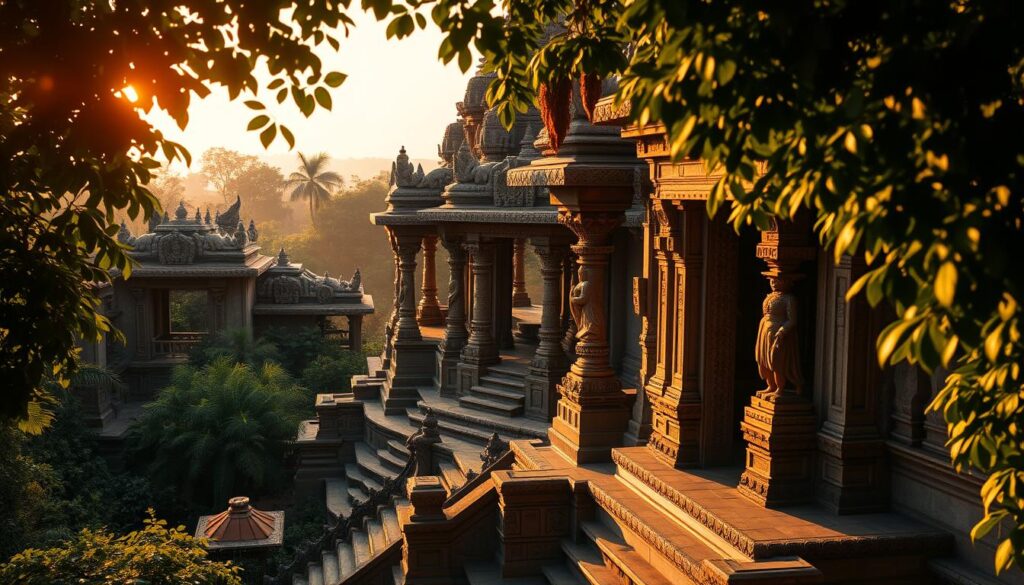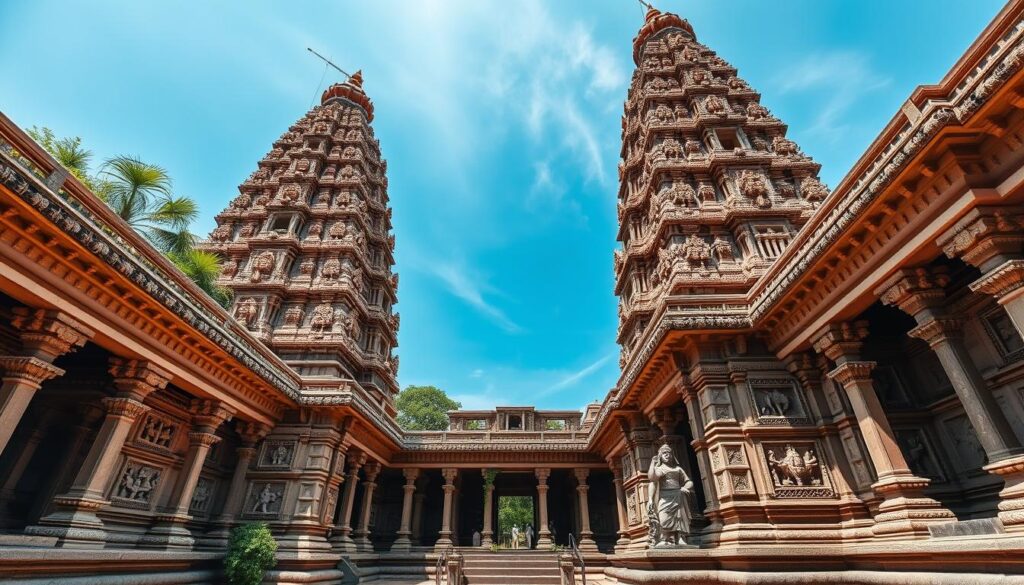The Parashurameshvara Temple is a key site in India, showing off the country’s rich culture through its beautiful Hindu architecture. It’s found in Bhubaneswar, making it a top spot for those who love Indian temples and their stories. Its mix of architectural styles makes it a standout attraction in Bhubaneswar, drawing visitors from everywhere.
Let’s dive into the Parashurameshvara Temple’s history and architecture. We’ll see what makes it a special spot in Bhubaneswar. It’s a key part of India’s cultural scene, showing the importance of Hindu architecture and Indian temples.
The Sacred Origins of Parashurameshvara Temple
The Parashurameshvara Temple’s story is deeply connected to Hindu mythology. It is linked to Lord Parashurama, the sixth form of Lord Vishnu. This temple shows the rich history of Hinduism, rooted in Lord Parashurama’s tales. It’s a mix of myth and reality, fascinating for those who love Hindu mythology and temple history.
Knowing the Parashurameshvara Temple’s history helps us understand its religious value. Its link to Lord Parashurama is key to its sacred origins. Exploring this connection helps us see the temple’s importance in Hindu mythology. The temple’s history goes beyond its beauty, showing a deep cultural and spiritual heritage.
Historical Background and Timeline
The Parashurameshvara Temple’s history is a mix of myth and real events. Looking at its timeline helps us understand its growth and importance in Hindu mythology. This gives us a richer appreciation of the temple’s role in Hinduism.
Religious Significance in Hinduism
The Parashurameshvara Temple is highly respected in Hinduism. Its religious importance is tied to Lord Parashurama’s legend. As a sacred place, it connects us to the divine, offering a space for spiritual reflection and worship. The temple’s significance in Hindu mythology shows the lasting power of faith and our search for meaning.
Legend of Lord Parashurama
The Parashurameshvara Temple’s story centers on Lord Parashurama, a key figure in Hindu mythology. The tales of Lord Parashurama reveal the complexities of human nature and the battle between good and evil. Exploring Lord Parashurama’s legend helps us understand the temple’s history and its role in Hinduism.
Location and Setting in Bhubaneswar
Bhubaneswar, the capital of Odisha, is a key spot for Bhubaneswar tourism. It’s filled with historical and architectural wonders. The Parashurameshvara Temple, a top attraction, is right in the city center. This makes it easy for both tourists and locals to visit.
Being part of the Indian city guides, Bhubaneswar is perfect for those who love temple locations and history. The city’s layout and transport options make it easy to explore. It’s a place where old and new architecture meet, offering a unique experience.
For those wanting to dive into local culture, Bhubaneswar has lots to offer. You can check out temples, try local food, and buy traditional crafts. Whether you’re into history, architecture, or just want to see how locals live, Bhubaneswar will impress you.
Architectural Brilliance of the Parashurameshvara Temple
The Parashurameshvara Temple is a true gem of Kalinga architecture. It shows off the area’s deep cultural and artistic roots. The temple’s design is filled with detailed carvings and sculptural wonders, blending Indian art styles.
The temple’s walls are covered in carvings from Hindu myths. This makes it a standout in Indian architecture and sculpture. The use of local materials like sandstone and granite is impressive. These materials are crafted into detailed designs and patterns.
The temple’s walls and pillars are adorned with sculptures that highlight the region’s rich culture. The sculptures are known for their fine details and precision. This shows the skill of ancient sculptors. The temple’s design is a perfect mix of beauty and function, with each part carefully made to create harmony.
Structural Elements and Design
The temple’s walls, pillars, and main shrine are designed to impress. The Kalinga architecture is known for its recessed niches, adding depth and texture. The temple is a masterpiece of Indian architecture and sculpture, showcasing the region’s cultural and artistic heritage.
Sacred Art and Symbolism
The Parashurameshvara Temple is filled with sacred art in India. Its walls and ceilings are covered in intricate carvings, sculptures, and paintings. Each part of the temple shows Hindu symbolism, highlighting the area’s rich culture and spirituality.
From the grand sculptures of Hindu gods to the fine carvings of flowers, the temple’s art is amazing. It shows the talent and hard work of the artists who made it.
The temple iconography is truly special. It has detailed carvings and sculptures of Hindu myths and daily life. The temple’s art also includes symbols from nature, like animals and plants.
This mix of spiritual and natural themes makes the temple’s art both unique and thought-provoking. It invites viewers to think deeply and reflect.
The Parashurameshvara Temple’s art and symbolism show the area’s rich cultural heritage. It combines sacred art in India and Hindu symbolism in a way that’s both stunning and meaningful. Exploring its art and symbolism helps us understand its spiritual and cultural value.
It also reminds us of the need to protect this incredible place for future generations to enjoy.
Notable Features and Highlights
The Parashurameshvara Temple is famous for its stunning temple architecture. It showcases the best of Indian shrine design. The main shrine is a work of art, with detailed walls and decorations.
The Indian shrine design of the temple is unique. It combines simplicity with grandeur. This makes it a favorite among tourists and architecture fans.
The temple’s outer walls are covered in detailed wall decorations. These decorations show scenes from Hindu mythology and everyday life. They add beauty and give insights into the local culture.
The temple’s architecture, like its tall spire and carved pillars, shows the skill of the craftsmen. It’s a testament to their talent.
The Parashurameshvara Temple is a key place to see India’s rich culture. Its temple architecture, Indian shrine design, and wall decorations are unforgettable. It’s a must-see for anyone interested in architecture, history, or just exploring.
Preservation and Restoration Efforts
India’s rich cultural heritage shines through its many historical temples, like the Parashurameshvara Temple. Keeping these ancient structures safe is key to preserving the country’s cultural legacy.

Efforts to protect the Parashurameshvara Temple from time’s damage are ongoing. These are part of a larger effort to save India’s historical sites and cultural treasures.
Restoration projects aim to fix and preserve the temple’s detailed carvings, sculptures, and design. These projects need careful planning and execution to keep the temple’s original look and history. Preserving temples and cultural heritage is vital, as it keeps India’s cultural identity alive and shows its rich past.
Supporting restoration and conservation efforts helps keep the Parashurameshvara Temple and other historical sites for future generations. Success in these efforts relies on teamwork from government, experts, and local communities. Together, we can protect India’s cultural heritage and foster a deeper love for its history and traditions.
Best Time to Visit and Access Information
Planning a trip to the Parashurameshvara Temple needs careful thought. You must consider the best time to go and how to get there. This section is part of a detailed Bhubaneswar travel guide. It aims to make your trip smooth and fun. Whether you’re into Indian tourism or want to know about temple visits, this guide is for you.
The weather is key when planning your visit. The temple is in a tropical area with hot summers and mild winters. The best time to visit is from October to February. This is when the weather is nice and perfect for exploring.
Weather Considerations
The weather greatly affects when to visit the Parashurameshvara Temple. Summers are very hot, and the monsoon can mess up travel plans. Thinking about these factors helps you plan better and enjoy your trip more.
Transportation Options
Getting to the temple is easy with many ways to travel. The closest airport is the Biju Patnaik International Airport, linked to big cities in India. From there, you can take a taxi or bus to the temple. The temple is also near the Bhubaneswar Railway Station, making it easy to reach by train.
Accommodation Nearby
| Hotel Name | Distance from Temple | Price Range |
|---|---|---|
| Hotel Mayfair | 5 km | Rs. 5,000 – Rs. 10,000 |
| Hotel Trident | 3 km | Rs. 3,000 – Rs. 6,000 |
| Hotel Ginger | 2 km | Rs. 2,000 – Rs. 4,000 |
With this info, you can plan your visit to the Parashurameshvara Temple. Enjoy your Bhubaneswar travel guide experience. Explore India’s rich heritage and get valuable temple visit information.
Photography and Documentation Guidelines
The Parashurameshvara Temple is a photographer’s dream. It’s filled with detailed carvings, sculptures, and stunning architecture. It’s important to follow the temple’s rules to take great photos and respect its sanctity.
For those who love Indian travel photography, this temple is a must-see. It showcases India’s rich cultural history through its architecture and art. By documenting this, visitors help keep the temple’s legacy alive for others to see.

Best Photo Spots
The temple’s main shrine and outer wall decorations are perfect for photos. The intricate carvings and sculptures on the walls and pillars are a photographer’s dream.
Photography Rules
Visitors can take photos for personal use, but need permission for commercial shots. It’s important to follow the temple’s rules. This includes not using flash or tripods and not touching the sculptures and carvings.
Recommended Equipment
A good camera with a wide-angle lens and tripod is best for capturing the temple’s beauty. For detailed shots of carvings and sculptures, a high-resolution camera with a macro lens is recommended.
Living Legacy: The Temple’s Impact on Indian Architecture
The Parashurameshvara Temple is a symbol of Indian architectural legacy. It has greatly influenced the design of many temples and historical sites in India. Its mix of cultural heritage and temple influence makes it a key icon in Indian architecture.
The temple’s Kalinga-style architecture and detailed sculptures have inspired many. Its preservation shows the community’s and government’s commitment. Visitors see the temple’s beauty and remember the Indian architectural legacy it represents.


